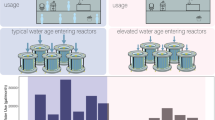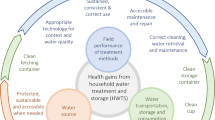Abstract
It is an increasingly common practice that drinking water distribution systems (DWDSs) may have to deliver new-quality water after decades of service. However, the so-called transition effects when old DWDSs receive new water remain unclear. In this 2 year longitudinal study, transition effects induced by the introduction of partial reverse osmosis in production were observed as marked increases in particle load, elemental concentrations and biomass. This occurred as soon as new-quality water entered the DWDS, lasted for 1 month and started to disappear from the second month. The peak transition window was around 1 month while the restabilization of microbial ecology and improvements in water quality take much longer—between 1 and 2 years. The number of immigrants from loose deposits and biofilm increased by 17.9% during the transition period but had decreased by 79.0% 2 years later. This study provides valuable insights into the occurrence and potential management strategies of transition effects.
This is a preview of subscription content, access via your institution
Access options
Subscribe to this journal
Receive 12 digital issues and online access to articles
$99.00 per year
only $8.25 per issue
Buy this article
- Purchase on Springer Link
- Instant access to full article PDF
Prices may be subject to local taxes which are calculated during checkout






Similar content being viewed by others
Data availability
The sequencing data have been deposited in the NCBI database, with reference code PRJNA967184. Source data are provided with this paper.
References
Liu, G. et al. Potential impacts of changing supply-water quality on drinking water distribution: a review. Water Res. 116, 135–148 (2017).
Edwards, M. & Dudi, A. Role of chlorine and chloramine in corrosion of lead-bearing plumbing materials. J. Am. Water Works Assoc. 96, 69–81 (2004).
Kim, E. J., Herrera, J. E., Huggins, D., Braam, J. & Koshowski, S. Effect of pH on the concentrations of lead and trace contaminants in drinking water: a combined batch, pipe loop and sentinel home study. Water Res. 45, 2763–2774 (2011).
Li, D. et al. Characterization of bacterial community structure in a drinking water distribution system during an occurrence of red water. Appl. Environ. Microbiol. 76, 7171–7180 (2010).
Schwake, D. O., Garner, E., Strom, O. R., Pruden, A. & Edwards, M. A. Legionella DNA markers in tap water coincident with a spike in Legionnaires’ disease in Flint, MI. Environ. Sci. Technol. Lett. 3, 311–315 (2016).
Zahran, S. et al. Assessment of the Legionnaires’ disease outbreak in Flint, Michigan. Proc. Natl Acad. Sci. USA 115, E1730–E1739 (2018).
Shannon, M. A. et al. Science and technology for water purification in the coming decades. Nature 452, 301–310 (2008).
Basefsky, M. Issues of aging infrastructure: the Tucson experience. Southwest Hydrol. 5, 24–25 (2006).
Reiber, S. & Dostal, G. Arsenic and old pipes—a mysterious liaison. Opflow 26, 1–12 (2000).
Makris, K. C., Andra, S. S. & Botsaris, G. Pipe scales and biofilms in drinking-water distribution systems: undermining finished water quality. Crit. Rev. Environ. Sci. Technol. 44, 1477–1523 (2014).
Chen, L. et al. Assessing the transition effects in a drinking water distribution system caused by changing supply water quality: an indirect approach by characterizing suspended solids. Water Res. 168, 115159 (2020).
Banna, M. H. et al. Online drinking water quality monitoring: review on available and emerging technologies. Crit. Rev. Environ. Sci. Technol. 44, 1370–1421 (2014).
Favere, J., Buysschaert, B., Boon, N. & De Gusseme, B. Online microbial fingerprinting for quality management of drinking water: full-scale event detection. Water Res. 170, 115353 (2020).
Besmer, M. D. et al. Online flow cytometry reveals microbial dynamics influenced by concurrent natural and operational events in groundwater used for drinking water treatment. Sci. Rep. 6, 38462 (2016).
Ikonen, J. et al. On-line detection of Escherichia coli intrusion in a pilot-scale drinking water distribution system. J. Environ. Manage. 198, 384–392 (2017).
Chen, L., Li, X., van der Meer, W., Medema, G. & Liu, G. Capturing and tracing the spatiotemporal variations of planktonic and particle-associated bacteria in an unchlorinated drinking water distribution system. Water Res. 219, 118589 (2022).
Hanna-Attisha, M., LaChance, J., Sadler, R. C. & Champney Schnepp, A. Elevated blood lead levels in children associated with the Flint drinking water crisis: a spatial analysis of risk and public health response. Am. J. Public Health 106, 283–290 (2016).
Schleheck, D. et al. Pseudomonas aeruginosa PAO1 preferentially grows as aggregates in liquid batch cultures and disperses upon starvation. PLoS ONE 4, e5513 (2009).
de Vries, H. J., Kleibusch, E., Hermes, G. D. A., van den Brink, P. & Plugge, C. M. Biofouling control: the impact of biofilm dispersal and membrane flushing. Water Res. 198, 117163 (2021).
Torvinen, E. et al. Mycobacteria in water and loose deposits of drinking water distribution systems in Finland. Appl. Environ. Microbiol. 70, 1973–1981 (2004).
Flemming, H. C., Percival, S. L. & Walker, J. T. Contamination potential of biofilms in water distribution systems. Water Sci. Technol. 2, 271–280 (2002).
Mackay, W. G., Gribbon, L. T., Barer, M. R. & Reid, D. C. Biofilms in drinking water systems – a possible reservoir for Helicobacter pylori. Water Sci. Technol. 38, 181–185 (1998).
Wingender, J. & Flemming, H. C. Biofilms in drinking water and their role as reservoir for pathogens. Int. J. Hyg. Environ. Health 214, 417–423 (2011).
Carrière, A., Gauthier, V., Desjardins, R. & Barbeau, B. Evaluation of loose deposits in distribution systems through unidirectional flushing. J. Am. Water Works Assoc. 97, 82–92 (2005).
Echeverría, F. et al. Characterization of deposits formed in a water distribution system. Ingeniare: Revista Chilena de Ingenieria 17, 275–281 (2009).
Gauthier, V., Gérard, B., Portal, J. M., Block, J. C. & Gatel, D. Organic matter as loose deposits in a drinking water distribution system. Water Res. 33, 1014–1026 (1999).
Liu, G. et al. Pyrosequencing reveals bacterial communities in unchlorinated drinking water distribution system: an integral study of bulk water, suspended solids, loose deposits, and pipe wall biofilm. Environ. Sci. Technol. 48, 5467–5476 (2014).
Zacheus, O. M., Lehtola, M. J., Korhonen, L. K. & Martikainen, P. J. Soft deposits, the key site for microbial growth in drinking water distribution networks. Water Res. 35, 1757–1765 (2001).
Mussared, A., Fabris, R., Vreeburg, J., Jelbart, J. & Drikas, M. The origin and risks associated with loose deposits in a drinking water distribution system. Water Supply 19, 291–302 (2019).
Liu, G. et al. Quantification and identification of particle-associated bacteria in unchlorinated drinking water from three treatment plants by cultivation-independent methods. Water Res. 47, 3523–3533 (2013).
Citulski, J. A., Farahbakhsh, K. & Kent, F. C. Effects of total suspended solids loading on short-term fouling in the treatment of secondary effluent by an immersed ultrafiltration pilot system. Water Environ. Res. 81, 2427–2436 (2009).
Liu, G. et al. Hotspots for selected metal elements and microbes accumulation and the corresponding water quality deterioration potential in an unchlorinated drinking water distribution system. Water Res. 124, 435–445 (2017).
Magic-Knezev, A. & Van Der Kooij, D. Optimisation and significance of ATP analysis for measuring active biomass in granular activated carbon filters used in water treatment. Water Res. 38, 3971–3979 (2004).
Caporaso, J. G. et al. QIIME allows analysis of high-throughput community sequencing data. Nat. Methods 7, 335–336 (2010).
Callahan, B. J. et al. DADA2: high-resolution sample inference from Illumina amplicon data. Nat. Methods 13, 581–583 (2016).
Quast, C. et al. The SILVA ribosomal RNA gene database project: improved data processing and web-based tools. Nucleic Acids Res. 41, D590–D596 (2012).
Knights, D. et al. Bayesian community-wide culture-independent microbial source tracking. Nat. Methods 8, 761–763 (2011).
Henry, R. et al. Into the deep: evaluation of SourceTracker for assessment of faecal contamination of coastal waters. Water Res. 93, 242–253 (2016).
Liu, G. et al. Assessing the origin of bacteria in tap water and distribution system in an unchlorinated drinking water system by SourceTracker using microbial community fingerprints. Water Res. 138, 86–96 (2018).
McCarthy, D. T. et al. Source tracking using microbial community fingerprints: method comparison with hydrodynamic modelling. Water Res. 109, 253–265 (2017).
Sloan, W. T. et al. Quantifying the roles of immigration and chance in shaping prokaryote community structure. Environ. Microbiol. 8, 732–740 (2006).
Ling, F., Whitaker, R., LeChevallier, M. W. & Liu, W. T. Drinking water microbiome assembly induced by water stagnation. ISME J. 12, 1520–1531 (2018).
Venkataraman, A. et al. Application of a neutral community model to assess structuring of the human lung microbiome. mBio 6, e02284–14 (2015).
Sprockett, D. D. et al. Microbiota assembly, structure, and dynamics among Tsimane horticulturalists of the Bolivian Amazon. Nat. Commun. 11, 3772 (2020).
Acknowledgements
The study has been financially supported by the National Key R&D programme (no. 2018YFE0204100), National Natural Science Foundation of China (nos. 52022103 and 51820105011) and the Chinese Scholarship Council (no. 201704910877).
Author information
Authors and Affiliations
Contributions
Conceptualization was undertaken by L.C. and G.L. Investigation and data curation were carried out by L.C. and X.L. L.C. and G.L. performed methodology. G.L., G.M. and W.v.d.M. provided support. L.C. and G.L. wrote the original draft. All authors carried out writing review and editing. W.v.d.M. and G.L. secured funding.
Corresponding author
Ethics declarations
Competing interests
The authors declare no competing interests.
Peer review
Peer review information
Nature Water thanks Kejia Zhang, Kara Nelson and the other, anonymous, reviewer(s) for their contribution to the peer review of this work.
Additional information
Publisher’s note Springer Nature remains neutral with regard to jurisdictional claims in published maps and institutional affiliations.
Supplementary information
Supplementary Information
Supplementary Tables 1–3 and Figs. 1–21.
Supplementary Data 1
Raw data for Supplementary Fig. 1.
Supplementary Data 2
Raw data for Supplementary Fig. 3.
Supplementary Data 3
Raw data for Supplementary Fig. 4.
Supplementary Data 4
Raw data for Supplementary Fig. 5.
Source data
Source Data Fig. 1
Raw data for Fig. 1b.
Source Data Fig. 2
Raw data for Fig. 2.
Rights and permissions
Springer Nature or its licensor (e.g. a society or other partner) holds exclusive rights to this article under a publishing agreement with the author(s) or other rightsholder(s); author self-archiving of the accepted manuscript version of this article is solely governed by the terms of such publishing agreement and applicable law.
About this article
Cite this article
Chen, L., Li, X., Medema, G. et al. Transition effects in an unchlorinated drinking water system following the introduction of partial reverse osmosis. Nat Water 1, 961–970 (2023). https://doi.org/10.1038/s44221-023-00149-7
Received:
Accepted:
Published:
Issue Date:
DOI: https://doi.org/10.1038/s44221-023-00149-7



